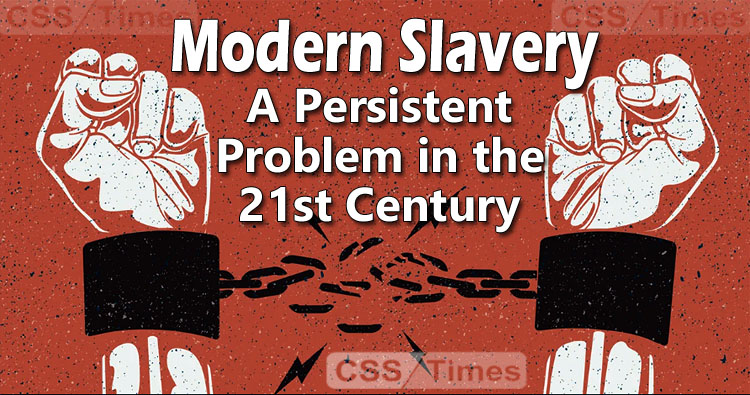Modern Slavery: A Persistent Problem in the 21st Century
Introduction
Slavery is widely considered to be a relic of the past, a dark chapter in human history that was abolished centuries ago. Unfortunately, this is far from the truth. Despite being illegal in every country, slavery still persists in many forms in the 21st century, affecting millions of people around the world. This article will explore the issue of modern slavery and its impact on society.
Defining Modern Slavery
Modern slavery refers to situations of exploitation that a person cannot leave because of threats, violence, coercion, deception, and abuse of power. It includes forced labor, human trafficking, debt bondage, forced marriage, and the sale of children. According to the International Labour Organization, an estimated 40.3 million people were victims of modern slavery in 2016, with the vast majority being women and children.
Types of Modern Slavery

Forced Labor:
Forced labor refers to work that is performed against a person’s will, often under the threat of violence or other forms of punishment. This can occur in a variety of settings, including factories, farms, mines, and construction sites.
Human Trafficking:
Human trafficking involves the recruitment, transportation, and exploitation of people, often for the purpose of forced labor or sexual exploitation. Trafficking can take many forms, including the smuggling of people across borders, the exploitation of migrant workers, and the exploitation of children in the sex trade.
Check also: Gender Studies MCQs
Debt Bondage:
Debt bondage refers to the exploitation of people who are forced to work to pay off a debt. This can occur when people are promised work or other opportunities in exchange for a loan, but then find themselves unable to pay back the debt and are forced to continue working.
Forced Marriage:
Forced marriage occurs when a person is married against their will, often as a result of threats, violence, or other forms of coercion. This can result in a range of exploitation, including forced labor, sexual exploitation, and domestic servitude.
Sale of Children:
The sale of children refers to the exploitation of children for the purpose of forced labor, sexual exploitation, or other forms of exploitation. This can occur when children are sold into slavery by their families, or when they are kidnapped and sold into slavery.
The Impact of Modern Slavery

Modern slavery has a devastating impact on the lives of those who are affected by it. In addition to the physical and emotional toll that it takes on individuals, modern slavery also has far-reaching social and economic impacts.
Human Rights Abuses:
Modern slavery violates a wide range of human rights, including the right to work in just and favorable conditions, the right to freedom from forced labor, and the right to life, liberty, and security of person.
Read also: Islamic World: A Rich Culture and History Spanning Centuries
Physical and Psychological Trauma:
Victims of modern slavery often suffer from physical and psychological trauma as a result of the exploitation they have experienced. This can include physical abuse, sexual abuse, and psychological manipulation.
Economic Costs:
Modern slavery has a significant economic impact, both in terms of the cost to society of dealing with the problem and in terms of the lost productivity of those who are enslaved.
Combating Modern Slavery

To effectively combat modern slavery, a multi-faceted approach is needed, involving a range of actors, including governments, international organizations, civil society, and the private sector.
Strengthening Laws and Enforcement:
Governments must strengthen their laws and enforcement efforts to prevent and punish modern slavery, including by cracking down on human trafficking, forced labor, and other forms of exploitation.
Improving Collaboration and Coordination:
International organizations, civil society, and the private sector must work together to share information, coordinate efforts, and pool resources to address modern slavery. This includes collaborating on efforts to identify and assist victims of modern slavery, as well as working to prevent the exploitation of vulnerable populations.
Raising Awareness and Engaging Communities:
Raising public awareness about modern slavery is critical to addressing the problem. This can be achieved through education and outreach efforts, as well as by engaging communities and encouraging them to report incidents of modern slavery.
Supporting Victims:
Providing support to victims of modern slavery is crucial to their recovery and reintegration into society. This can include providing medical and psychological support, as well as vocational training and other forms of assistance to help them rebuild their lives.
Addressing Root Causes:
To effectively address modern slavery, it is important to address the root causes of exploitation, such as poverty, conflict, and political instability. This can be achieved through efforts to promote economic growth, improve access to education and employment, and address social and political inequalities.
Conclusion
Modern slavery is a persistent and devastating problem in the 21st century, affecting millions of people around the world. To effectively combat this issue, a multi-faceted approach is needed, involving a range of actors, including governments, international organizations, civil society, and the private sector. By working together, it is possible to end modern slavery and ensure that all people are free to live and work in just and favorable conditions.
Check Our Complete collection of CSS Islamic Studies Notes
- Pakistan Observes Quran Sanctity Day to Protest Desecration of Holy Book in Sweden
- Islamic World: A Rich Culture and History Spanning Centuries
- The Ideal of Islamic Civilization and its Characteristics (CSS Islamic Studies Notes)
- Important Islamic Studies Q/A for All Competitive Exams
- Important Battles of Islam | CSS Islamic Studies Notes
- Seerah of Holy Prophet Muhammad (PBUH) As Educator | CSS Islamic Studies Notes
- An Introduction to Islamic Ideology Download Complete Book in PDF
- Wives of Prophet Muhammad (SAW) Azwaj-e-Mutaherat MCQs | Islamiat MCQs
- The Ancestors of Holy Prophet Muhammad (PBUH) | Islamiat MCQs for
- Seerah of Holy Prophet Muhammad (PBUH) As Diplomatic | CSS Islamic Studies Notes









[…] Read also: Modern Slavery: A Persistent Problem in the 21st Century […]
Sir, Mehrbani kr k download option de dya karen…. Tab gum ho jati he…